|
North
Plover Warden
11:30-3:30
Today's
Bird Sightings:
Plum Island
common grackle (4)
ring billed gull (11)
double crested cormorant (92)
great black backed gull (2)
least tern (4)
common tern (12)
herring gull (4)
Bonaparte's gull (1)
greater yellowlegs (1)
killdeer (3 adults, 3+ babies)
gadwall (6)
eastern kingbird (9)
redwinged blackbird (7)
snowy egret (12)
mute swan (3)
willet (3)
mourning dove (3)
yellow warbler (5)
Canada goose (12)
black bellied plover (2)
Forster's tern (1)
tree swallow (2)
bobolink (2)
brown thrasher (2)
least sandpiper (28)
dunlin (1)
short billed dowitcher (2)
American robin (1)
gray catbird (5)
American crow (2)
great egret (1)
Butterflies:
viceroy
cabbage white
Today's
Reading: Tibetan Trek by Ronald Kaulback, A
Flora of Essex County by Stuart K. Harris
Today's
Starting Pitcher: David Cone
2001
Book List
Plum
Island Bird List
for 2001
Plum
Island Life List
Photos
top to bottom:
hazy view to
the south
gull in
flight
two gulls
calling
sand
dollar
palmate hop
clover
chickweed
hudsonia
(a.k.a. beach heather)
a pink
flower (Deptford pink? moss campion?)
some kind of
Euphorbia?
birdsfoot
trefoil
swamp
dewberry
|
|
|
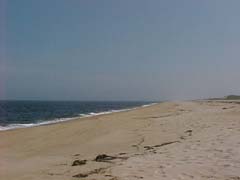 Weatherwise,
it's hazy, hot, and humid. HHH as the
weathermen like to say. Weatherwise,
it's hazy, hot, and humid. HHH as the
weathermen like to say.
Piping-plover-wise, chicks are
starting to hatch. The report from last week's survey
(attached to the clipboard) lists 2 chicks hatched and the
biologists are out there surveying now to see how many more
there are. The guy on the early shift says he hasn't seen
any. We chat a little bit about
the beach - he's a geologist and knows about barrier beach
processes - and about gulls 'cause I'm looking for the
Franklin's gull that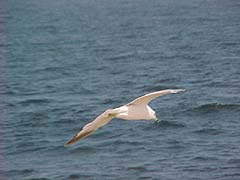 has been reported from the northern end of the refuge beach
the past few days.
has been reported from the northern end of the refuge beach
the past few days.
I brought my scope with me today in
hopes of getting a good look at a piping plover or maybe
that Franklin's gull. However, it is so hazy I can barely
see the beach and definitely can't identify even the great
black back gulls except by instinct. Mt. Agamenticus is
completely invisible to the north, ditto for the Isles of
Shoals, or any geographic features north of Atty. May's
restaurant. The haze shimmers and shakes. It makes things
look gigantic but covered in wavy lines. The biologists on
their ATVs could be an amphibious landing force in troop
transports or even aliens in UFOs. All  the
scope does is make the wavy lines more obvious. the
scope does is make the wavy lines more obvious.
Herring gulls and ring billed gulls
are very active today, flying low over the beach between me
and the waves making lots of noise. Periodically a
Bonaparte's gull goes by, always the same one - a non
breeding adult. Something that looks like it could be a
laughing gull - or maybe even that rare visitor the
Franklin's gull - lands on the beach just south of where the
majority of the great black backs and ring bills have been
hanging out. That makes it just south of where I can make
out any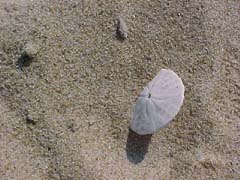 detail through the haze. I keep waiting for it to come
closer out of the haze but it chooses to move further south
and fades into invisibility. Guess I'll never know whether
it was the Franklin's gull or not. I don't bother to write
it in the notebook.
detail through the haze. I keep waiting for it to come
closer out of the haze but it chooses to move further south
and fades into invisibility. Guess I'll never know whether
it was the Franklin's gull or not. I don't bother to write
it in the notebook.
The biologists continue to approach
through the haze to the point where  they
are clearly identifiable as biologists on ATVs instead of an
amphibious landing force. A
visitor wants to know if she can look through my scope and
see the piping plovers or the least terns. She spots the
biologists and can tell me which way they're looking with
their binoculars. I guess the scope does provide a tiny bit
more detail. Anyway, when they finally get to my station,
they don't have time to stop and talk so I remain in the
dark about current chick numbers. I've gotta wonder how they
can see piping plovers, which are practically invisible
anyway, in this haze. they
are clearly identifiable as biologists on ATVs instead of an
amphibious landing force. A
visitor wants to know if she can look through my scope and
see the piping plovers or the least terns. She spots the
biologists and can tell me which way they're looking with
their binoculars. I guess the scope does provide a tiny bit
more detail. Anyway, when they finally get to my station,
they don't have time to stop and talk so I remain in the
dark about current chick numbers. I've gotta wonder how they
can see piping plovers, which are practically invisible
anyway, in this haze.
I speak with a steady stream of
visitors (total 12) all of whom are nice
and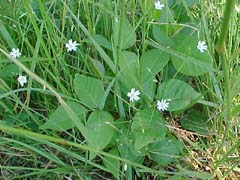 genuinely interested in the piping plover, even the guy who
told me he had a piping plover meal at the Pillar House
recently. I tell him I've heard it takes six to make a meal.
He says the Pillar House only served four. Mention of the
Pillar House, which is in Newton, prompts me to identify
myself as being from West Newton. The guy asks "what part?"
and as I'm about to answer - trying to formulate an answer
that clearly indicates I am not from the hill - he
adds "near Cherry Street?" Wow, apparently he has not taken
me as a rich type from the hill but as a working class type
from the other side of West Newton. He starts naming
families - all Italian names - to see if I know them. So and
so? Such and
genuinely interested in the piping plover, even the guy who
told me he had a piping plover meal at the Pillar House
recently. I tell him I've heard it takes six to make a meal.
He says the Pillar House only served four. Mention of the
Pillar House, which is in Newton, prompts me to identify
myself as being from West Newton. The guy asks "what part?"
and as I'm about to answer - trying to formulate an answer
that clearly indicates I am not from the hill - he
adds "near Cherry Street?" Wow, apparently he has not taken
me as a rich type from the hill but as a working class type
from the other side of West Newton. He starts naming
families - all Italian names - to see if I know them. So and
so? Such and 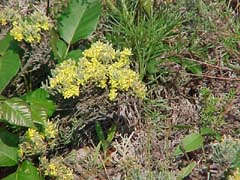 such?
Mumblefratz? Whoa, Mumblefratz? You bet I know them. My
brother took Patrick Mumblefratz golfing the day of his
wedding. Boy was he ever in trouble. Mrs. Mumblefratz kept
calling our house every fifteen minutes demanding to know
where my brother had taken the groom. Young Mumblefratz did
make it to his wedding on time, but I don't think his mother
ever spoke to my brother again. Small world as they say. At
least the guy stops talking about eating piping plovers
:-) such?
Mumblefratz? Whoa, Mumblefratz? You bet I know them. My
brother took Patrick Mumblefratz golfing the day of his
wedding. Boy was he ever in trouble. Mrs. Mumblefratz kept
calling our house every fifteen minutes demanding to know
where my brother had taken the groom. Young Mumblefratz did
make it to his wedding on time, but I don't think his mother
ever spoke to my brother again. Small world as they say. At
least the guy stops talking about eating piping plovers
:-)
When my shift is over, I have several
insect bites (mosquito and possibly my first greenhead bite
of the season - it bit me in the butt so I didn't see it), a
sunburned little toe (first barefoot shift of the season and
I missed a spot with the sunscreen), and sand in my socks.
The haze has lifted a tiny bit and more importantly a breeze
has come up to cool things off. I am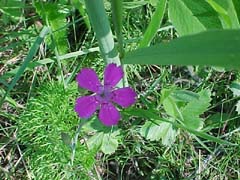 reluctant to leave the island for the heat of the city so I
turn in my report and bang a U-turn on the refuge road for
some birding and botanizing. I saw a small patch of palmate
hop clover this morning and realized I hadn't photographed
it yet, but could I remember where it was after baking my
brain for 4 hours? I go looking for it and discover lots of
it in several spots.
reluctant to leave the island for the heat of the city so I
turn in my report and bang a U-turn on the refuge road for
some birding and botanizing. I saw a small patch of palmate
hop clover this morning and realized I hadn't photographed
it yet, but could I remember where it was after baking my
brain for 4 hours? I go looking for it and discover lots of
it in several spots.
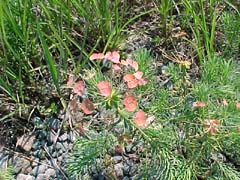 With
the breeze picking up it's even possible to walk along the
Hellcat dike without being bitten although the people I meet
coming from there tell me I'll need bug repellent. I don't'
get anymore insect bites, and I am rewarded with great looks
at a Forster's tern. Cormorants are having a field day. It's
a regular cormorant party. They keep arriving in groups of
five, splash landing in the Bill Forward Pool, and then
diving making as much splashing as possible. Only one is
sitting drying its wings, the odd cormorant out. There's a
ton of shorebirds too, and I make out most of 'em but can't
walk any further along the dike because a redwinged
blackbird couple whose nest is apparently somewhere in the
grasses next to the pool keep threatening me with grievous
bodily harm when I take one step past the observation
tower. With
the breeze picking up it's even possible to walk along the
Hellcat dike without being bitten although the people I meet
coming from there tell me I'll need bug repellent. I don't'
get anymore insect bites, and I am rewarded with great looks
at a Forster's tern. Cormorants are having a field day. It's
a regular cormorant party. They keep arriving in groups of
five, splash landing in the Bill Forward Pool, and then
diving making as much splashing as possible. Only one is
sitting drying its wings, the odd cormorant out. There's a
ton of shorebirds too, and I make out most of 'em but can't
walk any further along the dike because a redwinged
blackbird couple whose nest is apparently somewhere in the
grasses next to the pool keep threatening me with grievous
bodily harm when I take one step past the observation
tower.
Today's bird in the road where the
suicidal mourning doves usually are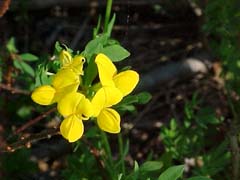 (you will recall yesterday's was a kingbird) is a yellow
warbler. Actually two yellow warblers pecking at each other
furiously. The fight, fly up a little, land back in the
road. I wait 'til they finally take the fight into some
bushes. I have never in my entire life seen a yellow warbler
sit on the road. What is it about that stretch of road?
(you will recall yesterday's was a kingbird) is a yellow
warbler. Actually two yellow warblers pecking at each other
furiously. The fight, fly up a little, land back in the
road. I wait 'til they finally take the fight into some
bushes. I have never in my entire life seen a yellow warbler
sit on the road. What is it about that stretch of road?
 The
first really summery day of summer only comes 'round once
and these long days make me feel like I have to use up every
last ray of light before I head home. I know there are
willow flycatchers, a black tern, and that elusive
Franklin's gulls to track down and I could easily stay here
'cause I know it will be just beastly at home. However,
I'm eager to shake the sand out of my shorts, wash the
sunscreen off, and change my socks. Not to mention I have
entirely forgotten to eat since breakfast. The
first really summery day of summer only comes 'round once
and these long days make me feel like I have to use up every
last ray of light before I head home. I know there are
willow flycatchers, a black tern, and that elusive
Franklin's gulls to track down and I could easily stay here
'cause I know it will be just beastly at home. However,
I'm eager to shake the sand out of my shorts, wash the
sunscreen off, and change my socks. Not to mention I have
entirely forgotten to eat since breakfast.
As I guessed, it's way hotter back
inland in North Andover.
|
 Weatherwise,
it's hazy, hot, and humid. HHH as the
weathermen like to say.
Weatherwise,
it's hazy, hot, and humid. HHH as the
weathermen like to say. has been reported from the northern end of the refuge beach
the past few days.
has been reported from the northern end of the refuge beach
the past few days.  the
scope does is make the wavy lines more obvious.
the
scope does is make the wavy lines more obvious. detail through the haze. I keep waiting for it to come
closer out of the haze but it chooses to move further south
and fades into invisibility. Guess I'll never know whether
it was the Franklin's gull or not. I don't bother to write
it in the notebook.
detail through the haze. I keep waiting for it to come
closer out of the haze but it chooses to move further south
and fades into invisibility. Guess I'll never know whether
it was the Franklin's gull or not. I don't bother to write
it in the notebook. they
are clearly identifiable as biologists on ATVs instead of an
amphibious landing force. A
visitor wants to know if she can look through my scope and
see the piping plovers or the least terns. She spots the
biologists and can tell me which way they're looking with
their binoculars. I guess the scope does provide a tiny bit
more detail. Anyway, when they finally get to my station,
they don't have time to stop and talk so I remain in the
dark about current chick numbers. I've gotta wonder how they
can see piping plovers, which are practically invisible
anyway, in this haze.
they
are clearly identifiable as biologists on ATVs instead of an
amphibious landing force. A
visitor wants to know if she can look through my scope and
see the piping plovers or the least terns. She spots the
biologists and can tell me which way they're looking with
their binoculars. I guess the scope does provide a tiny bit
more detail. Anyway, when they finally get to my station,
they don't have time to stop and talk so I remain in the
dark about current chick numbers. I've gotta wonder how they
can see piping plovers, which are practically invisible
anyway, in this haze. genuinely interested in the piping plover, even the guy who
told me he had a piping plover meal at the Pillar House
recently. I tell him I've heard it takes six to make a meal.
He says the Pillar House only served four. Mention of the
Pillar House, which is in Newton, prompts me to identify
myself as being from West Newton. The guy asks "what part?"
and as I'm about to answer - trying to formulate an answer
that clearly indicates I am not from the hill - he
adds "near Cherry Street?" Wow, apparently he has not taken
me as a rich type from the hill but as a working class type
from the other side of West Newton. He starts naming
families - all Italian names - to see if I know them. So and
so? Such and
genuinely interested in the piping plover, even the guy who
told me he had a piping plover meal at the Pillar House
recently. I tell him I've heard it takes six to make a meal.
He says the Pillar House only served four. Mention of the
Pillar House, which is in Newton, prompts me to identify
myself as being from West Newton. The guy asks "what part?"
and as I'm about to answer - trying to formulate an answer
that clearly indicates I am not from the hill - he
adds "near Cherry Street?" Wow, apparently he has not taken
me as a rich type from the hill but as a working class type
from the other side of West Newton. He starts naming
families - all Italian names - to see if I know them. So and
so? Such and  such?
Mumblefratz? Whoa, Mumblefratz? You bet I know them. My
brother took Patrick Mumblefratz golfing the day of his
wedding. Boy was he ever in trouble. Mrs. Mumblefratz kept
calling our house every fifteen minutes demanding to know
where my brother had taken the groom. Young Mumblefratz did
make it to his wedding on time, but I don't think his mother
ever spoke to my brother again. Small world as they say. At
least the guy stops talking about eating piping plovers
:-)
such?
Mumblefratz? Whoa, Mumblefratz? You bet I know them. My
brother took Patrick Mumblefratz golfing the day of his
wedding. Boy was he ever in trouble. Mrs. Mumblefratz kept
calling our house every fifteen minutes demanding to know
where my brother had taken the groom. Young Mumblefratz did
make it to his wedding on time, but I don't think his mother
ever spoke to my brother again. Small world as they say. At
least the guy stops talking about eating piping plovers
:-) reluctant to leave the island for the heat of the city so I
turn in my report and bang a U-turn on the refuge road for
some birding and botanizing. I saw a small patch of palmate
hop clover this morning and realized I hadn't photographed
it yet, but could I remember where it was after baking my
brain for 4 hours? I go looking for it and discover lots of
it in several spots.
reluctant to leave the island for the heat of the city so I
turn in my report and bang a U-turn on the refuge road for
some birding and botanizing. I saw a small patch of palmate
hop clover this morning and realized I hadn't photographed
it yet, but could I remember where it was after baking my
brain for 4 hours? I go looking for it and discover lots of
it in several spots. With
the breeze picking up it's even possible to walk along the
Hellcat dike without being bitten although the people I meet
coming from there tell me I'll need bug repellent. I don't'
get anymore insect bites, and I am rewarded with great looks
at a Forster's tern. Cormorants are having a field day. It's
a regular cormorant party. They keep arriving in groups of
five, splash landing in the Bill Forward Pool, and then
diving making as much splashing as possible. Only one is
sitting drying its wings, the odd cormorant out. There's a
ton of shorebirds too, and I make out most of 'em but can't
walk any further along the dike because a redwinged
blackbird couple whose nest is apparently somewhere in the
grasses next to the pool keep threatening me with grievous
bodily harm when I take one step past the observation
tower.
With
the breeze picking up it's even possible to walk along the
Hellcat dike without being bitten although the people I meet
coming from there tell me I'll need bug repellent. I don't'
get anymore insect bites, and I am rewarded with great looks
at a Forster's tern. Cormorants are having a field day. It's
a regular cormorant party. They keep arriving in groups of
five, splash landing in the Bill Forward Pool, and then
diving making as much splashing as possible. Only one is
sitting drying its wings, the odd cormorant out. There's a
ton of shorebirds too, and I make out most of 'em but can't
walk any further along the dike because a redwinged
blackbird couple whose nest is apparently somewhere in the
grasses next to the pool keep threatening me with grievous
bodily harm when I take one step past the observation
tower. (you will recall yesterday's was a kingbird) is a yellow
warbler. Actually two yellow warblers pecking at each other
furiously. The fight, fly up a little, land back in the
road. I wait 'til they finally take the fight into some
bushes. I have never in my entire life seen a yellow warbler
sit on the road. What is it about that stretch of road?
(you will recall yesterday's was a kingbird) is a yellow
warbler. Actually two yellow warblers pecking at each other
furiously. The fight, fly up a little, land back in the
road. I wait 'til they finally take the fight into some
bushes. I have never in my entire life seen a yellow warbler
sit on the road. What is it about that stretch of road?
 The
first really summery day of summer only comes 'round once
and these long days make me feel like I have to use up every
last ray of light before I head home. I know there are
willow flycatchers, a black tern, and that elusive
Franklin's gulls to track down and I could easily stay here
'cause I know it will be just beastly at home. However,
I'm eager to shake the sand out of my shorts, wash the
sunscreen off, and change my socks. Not to mention I have
entirely forgotten to eat since breakfast.
The
first really summery day of summer only comes 'round once
and these long days make me feel like I have to use up every
last ray of light before I head home. I know there are
willow flycatchers, a black tern, and that elusive
Franklin's gulls to track down and I could easily stay here
'cause I know it will be just beastly at home. However,
I'm eager to shake the sand out of my shorts, wash the
sunscreen off, and change my socks. Not to mention I have
entirely forgotten to eat since breakfast.